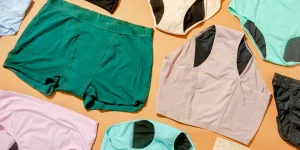By: Chloe Vickar (she/her)
Although period management options have improved significantly in the last half century, there is still work to be done to improve period products for the well-being of those who use them, and the well-being of the environment. As we work towards implementing menstrual justice in our communities, we must also prioritize the environmental cost of menstruating.
The environmental impact of period products can be measured by looking at the use of raw materials, energy, and water during the manufacturing processes, the makeup of the components of the products (plastic versus cotton, for example), the packaging of the products, and the total quantity of how many products are used and disposed of globally. However, there is little available literature on the exact environmental impact of disposable period products.

In addition to pads, tampons create significant waste. In the United States, approximately 12 billion pads and 7 million tampons are used each year. The plastic applicators are often marketed as recyclable; however, these pieces are rarely actually recycled. The presence of blood/organic matter disqualifies the applicators from being eligible to recycle in most jurisdictions. Further, as much as 400 pounds of packaging from period products is discarded for each person that menstruators in their lifetime.
Many reusable period products are available as alternatives to disposable pads and tampons. Menstrual cups, discs, reusable pads, and period underwear are among the most popular. Cups and discs are worn internally and made of medical grade silicone, or other body-safe ingredients like TPE, and can be washed and reused for up to 10 years, depending on the brand and the user. In addition to their environmental benefits, cups and discs often hold more menstrual blood than pads and tampons. There are many options for shape, size, and capacity, depending on the menstruator’s anatomy and flow.

Period underwear is increasing in popularity in recent years. It features an absorbent gusset and can be washed and reused for years. Period underwear often holds less menstrual blood than cups or discs but can be worn as backup for leaks in addition to an internal product, or by itself during spotting or for those with a light flow.
There are options for disposable pads and tampons that have lighter environmental footprints than plastic-based products. Pads and tampons made of cotton are healthier for the person using them and for the environment.
Reusable products are not suitable for all bodies, lifestyles, and circumstances, for example due to lack of resources, education, or personal preference. While reusable period products can last many years, they have higher upfront costs than disposable products. Further, internal reusable options such as cups and discs may not work well for all bodies, as each menstruator has different preferences based on their individual needs. Reusable pads are a great option for reducing waste, however one must be able carry the used pad with them until they can be laundered. Therefore, healthier disposable options made from organic cotton are important.
This savings calculator from Winnipeg-based reusable period product company Tree Hugger Cloth Pads illustrates financial and environmental savings from switching to reusable cloth pads.
Environmental impact must be taken into consideration when conceptualizing period products, however disposable options continue to be necessary. The waste associated with disposable products cannot be used as an argument to discourage the importance of free period products. We can advocate for accessibility of products, including disposable and reusable products, so that all menstruators have safe and reliable products.
For more information about the environmental impact of period products, check out these resources:
https://www.washingtonpost.com/wellness/2023/09/12/period-products-absorption-study-blood
Hand, J., Hwang, C., Vogel, W., Lopez, C., & Hwang, S. (2023). An exploration of market organic sanitary products for improving menstrual health and environmental impact. Journal of Water, Sanitation, and Hygiene for Development, 13(2), 63–77. https://doi.org/10.2166/washdev.2023.020
Harrison, M. E., & Tyson, N. (2023). Menstruation: Environmental impact and need for global health equity. International Journal of Gynecology and Obstetrics, 160(2), 378–382. https://doi.org/10.1002/ijgo.14311
https://www.treehuggerclothpads.com
https://www.treehuggerclothpads.com/pages/savings-calculator
May 28th is menstrual hygiene day, and this year, the theme is “Together for a #PeriodFriendlyWorld.” While this observance was originally framed as menstrual hygiene – we follow the lead of the World Health Organization, who calls for menstrual health to be recognized, framed, and addressed as a human rights issue, not a hygiene issue. Framing menstruation as such is a reflection of the taboo and stigma around periods. The labelling of period supplies as “feminine hygiene products” is incorrect since as Dr. Jen Gunther explains “needing them is not a sign of being feminine – it’s a sign that you need something to catch blood – and they’re not hygiene products because menstruating is not unhygienic.”
In 2023-2024, the Centre for Human Rights Research at the University of Manitoba has worked on the “Period Poverty & Equity, On Campus and Beyond” project to assess access to period supplies for the University of Manitoba community and to work towards menstrual equity, on campus and in the community. This series of essays is part of the Period Poverty & Equity, On Campus and Beyond project and aims to explore issues of menstrual justice that are often overlooked.

